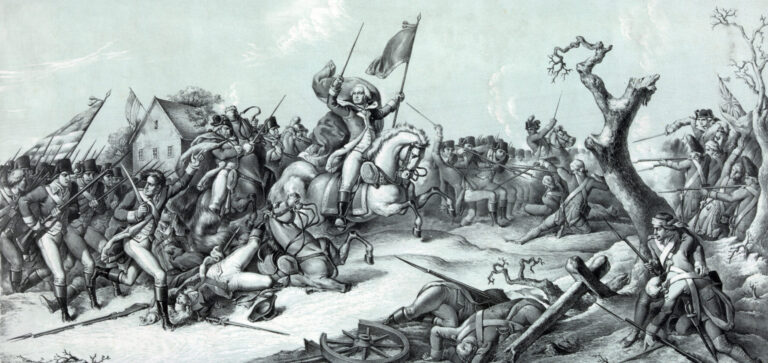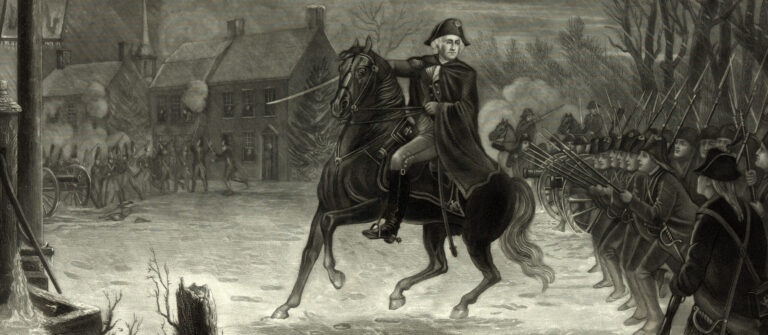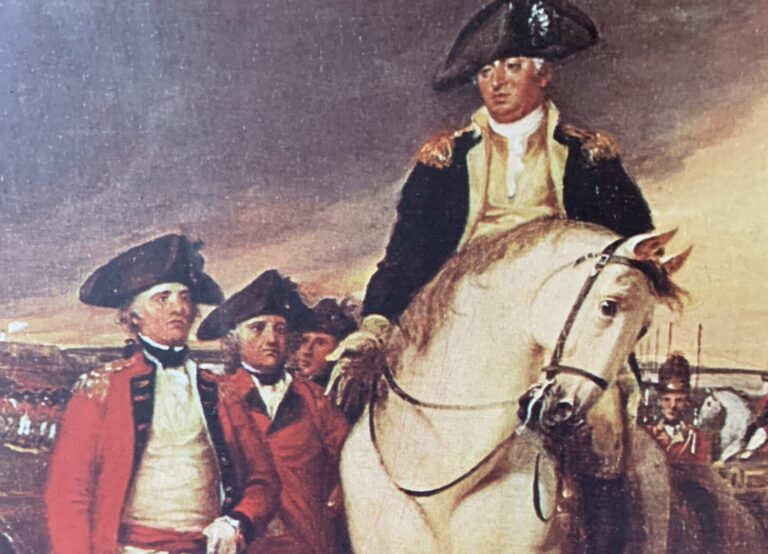Reminder: If you’re reading this in your email, you have to go to dpauthor.com and click on the Speaking of Which tab in order to view the actual blog post with the featured image.
Pyrrhic Victories
The resilience displayed by the Continental Army was paramount in England’s failure to defeat the American rebellion, especially as that insurrection was supported by weapons and ammunition from France and then subsequently by the armed forces of its monarch, Louis XVI. According to 18th-century military protocol, the side that held the field at the conclusion of battle was regarded as victorious; and, from that perspective, the redcoats won most of the Revolutionary War engagements from 1775 to 1783. They achieved unambiguous success (in chronological order) at Long Island, Kip’s Bay, Fort Washington, Brandywine Creek, Paoli, Germantown, Savannah, Charleston, Camden, and Waxhaws, while suffering clear-cut defeats at Princeton, Saratoga, Stony Point, Cowpens, and Yorktown. But they also “won” in a narrow tactical sense at Breed’s Hill, White Plains, Freeman’s Farm, Guilford Courthouse, Hobkirk Kill, and Eutaw Springs, by forcing the Americans to retire from the battlefield. However, those technical victories represented a strategic setback for the crown’s forces in that they depleted their precious reserves of military manpower, failed to neutralize enemy armies in the field, and were unable to sway public opinion against the insurrection.
When General Nathanael Greene, who was chosen by Washington to lead the Continental Army in the Southern Theater in 1780, memorably asserted his resolve to rebound from one of those purely tactical reversals, he arguably articulated the overall strategy behind the American war effort. Writing to the Chevalier de La Luzerne, Louis XVI’s minister to the United States, three days after the battle of Hobkirk Hill—near Camden, South Carolina—in April 1781, Greene declared, “We fight, get beat, rise, and fight again.”
A Case in Point
Hobkirk Hill is an illustrative example of the pyrrhic victories by the king’s troops that proved their undoing. This was a classic eighteenth-century battlefield engagement in which the opposing lines exchanged musket fire, at close range and in the open, until one side pulled back. Greene’s casualties were 270 (including 136 missing), and the British 258. Estimates vary as to the number of killed, wounded, captured, or missing on both sides, but the numerical equivalence between the respective casualty counts obscures a very disparate impact. The losses represented about 29 percent of the British force versus about 17 percent of the American.
The casualties sustained by the redcoats were substantial enough—along with other actions during this period, including the fall of Fort Watson to a rebel contingent led by Lieutenant Colonel Henry “Light Horse Harry” Lee (father of Confederate general Robert E. Lee) and General Francis Marion (the legendary “Swamp Fox”) just two days before—that the British commander, Colonel Francis, Lord Rawdon, abandoned his position at Camden and fell back to Monk’s Corner on the Cooper River thirty miles north of Charleston. By doing so, Rawdon yielded the key British post in South Carolina, and significant strategic consequences ensued. This began the unraveling of Britain’s tenuous hold over the interior of the state, for one after another of the posts occupied by its regulars or Loyalist units fell to the rebels—Fort Granby, Fort Motte, Orangeburg, Fort Galpin, and Georgetown in South Carolina, and Augusta in Georgia.
Winning By Not Losing
In the end, the Continental Army and its supporting militia prevailed in a war of attrition against a military superior opponent, That achievement was notwithstanding the various challenges posed by man and nature: battlefield reverses; desertions; expiring enlistments; the specter of mutiny; illness; and ongoing shortages of equipment, food, and supplies—and in spite of the many unforced errors made by American generals.
The insurgent side won the contest by not losing it. A lengthy war of attrition eventually sapped Britain’s will to fight following Lord Cornwallis’s surrender to the Franco-American army at Yorktown, Virginia in October 1781. There followed parliament’s vote to abandon the struggle and any claim to sovereignty over the 13 former colonies. What did England have to show for its eight-year-long effort to subdue the rebellion? Losses of 40,000 casualties and 50,000,000 pounds, including at least 20,000 soldiers and sailors whose lives ended in America, the West Indies, or at sea, some from battlefield wounds but more from disease—often in some squalid setting—and typically without the benefit of a stone to mark the final resting place of anyone other than a commissioned officer.
In a Broader Sense
All this begs the question of whether Britain could have ever “won” in terms of indefinitely suppressing the American quest for independence or whether that independence was inevitable. If as John Adams insisted, the revolution was in the minds and hearts of the people (the Whig faction, to be sure), would a purely military victory by the crown have made that population any more amenable to subjugation? Could the mother country have possibly borne the cost of deploying a permanent army of occupation in the colonies large enough to effectively impose British rule over a largely hostile people spread across an expanse of territory that dwarfed Great Britain in size? For how long? What reason is there to assume that her North American colonies would not at some point have attained their sovereignty given what happened with Australia, Canada, India, Ireland, and New Zealand? Surely it’s a question of when and not whether that would have occurred. In this context, I’m reminded of remarks by the great parliamentary orator Edmund Burke in March 1775, arguing for a policy of conciliation towards America, that included this: “Magnanimity in politics is not seldom the truest wisdom, and a great empire and little minds go ill together.”
Much of the preceding is adapted from my upcoming book, Winning the Ten Crucial Days. For those interested, the manuscript is now in the hands of the publisher, Brookline Books (an imprint of Casemate Publishers), and an image of the preliminary front-cover cover design can be viewed here.
If you’d like to read more about the battle of Hobkirk Hill, check out my article in the Journal of the American Revolution—Hobkirk Hill: A Major Minor Battle (June 27, 2023).



